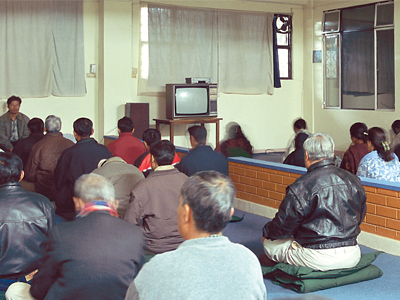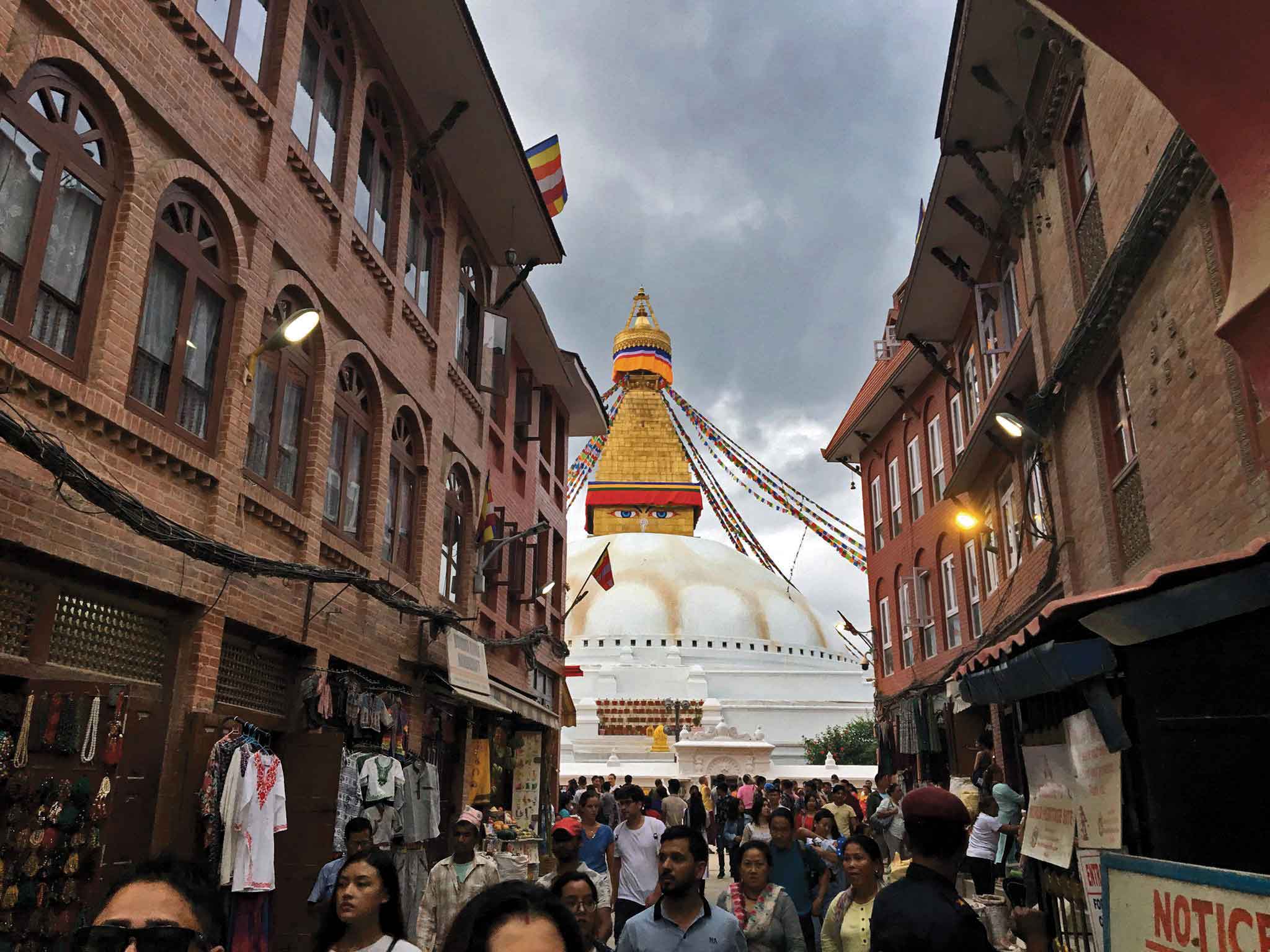Buddha means ‘the enlightened one’. According to Buddhist teachers, the power to enlighten ourselves lies within all of us; we just have to open ourselves to the fact and be willing to examine ourselves patiently and relinquish our desires towards the results. All of us are suffering in one way or the other. Suffering co-exists with mankind. Siddhartha Gautama questioned the reasons behind suffering and sought to find a way out of suffering. Gautama tried out various paths but finally found success through a type of meditation referred to as ‘Vipassana’ in the Pali texts. He distributed this knowledge freely to others around him so that others could benefit from it.
 Vipassana means ‘insight’, to see things as they really are. This most ancient meditation technique was taught 2500 years ago in India. Over time the method took on different forms as the different branches of Buddhism developed in different ways. In Burma, the basic Vipassana technique was preserved by imparting knowledge from teacher to students.
Vipassana means ‘insight’, to see things as they really are. This most ancient meditation technique was taught 2500 years ago in India. Over time the method took on different forms as the different branches of Buddhism developed in different ways. In Burma, the basic Vipassana technique was preserved by imparting knowledge from teacher to students.
By 1969, there were only a handful of active Vipassana
practitioners. At that time, Sri S.N.Goenka revived the knowledge of Vipassana techniques in India after his teacher, Sayagyi U Ba Khin, authorized him as a Vipassana teacher. Goenka, a successful industrialist at the time, met U Ba Khin in Burma when he was seeking a cure for his severe migraine. U Ba Khin agreed to teach him only if Goenka came with the intention of learning the technique of meditation and not with the intention of seeking a cure for his ailment. Goenka agreed and grew to become a full-fledged teacher of Vipassana. In Vipassana, Goenka found a discipline that went far beyond curing his physical ailments and went beyond religious and cultural barriers.
William Hart states in his book ‘Vipassana, The Art of Living,’ that the Buddha never claimed to be divine or divinely inspired; whatever special qualities he had were human qualities that he had mastered. So Hart found it logical that whatever the Buddha achieved is within the grasp of any human who works with his methods. Buddha called his teaching ‘Dharma’, which means the ‘law’ or the law of nature. Buddha emphasized that he taught only what he had experienced through direct knowledge and he encouraged others to develop such knowledge themselves.
Although it began witand commercial intent. Its only stated aim is to teach universal truths.h Buddha, most people feel that Vipassana is not a religion. It doesn’t teach the full version of Buddhism; doesn’t ask people to convert; doesn’t involve rituals, Mantras, Tantras, Guru worship,
Vipassana is now taught at ten-day residential courses at over 100 Vipassana centers all over the world. In Nepal, the main center, Dharma Shring is in Kathmandu, near Budhanilkantha at Shivpuri hills. Other centers are Dharma Terai in Birgunj, Dharma Janani in Lumbini, Dharma Terai in Biratnagar, and two more centers are coming up in Pokhara and Chitwan.
The teaching, accommodation and food are all free of cost. All Dharma centers run on donations given by experienced students who wish to spread this knowledge so that more can benefit from it. None of the teachers, assistant teachers or volunteers are paid for their services at the center. Around 2500 to 3000 new meditators from all backgrounds, ages, professions and religions (out of which ten to fifteen percent are foreigners) join the meditation courses every year in Nepal.
The only criteria for selection of students is that one has to be sincerely willing to learn meditation and follow the rules strictly during one’s stay at the center. For foreign students’ benefit, translated discourses and instructions are available in seventeen languages at the center in Kathmandu. Special considerations are made for physically challenged students.
The course was originally taught in seven weeks at a time and has been re-designed into the present ten-day course – the least possible time period in which the technique can be fully absorbed - for the benefit of busy modern day people. For serious practitioners there are Satipatthana courses and other twenty to thirty-day courses that one can take only after going through 3 ten-day courses and a year of regular practice.
Vipassana for Children
180 girls and boys attended the recently conducted 3-day courses for children between 8 and 12. Pawan and Anju, two of the young participants said they had great fun and yes, they would like to go again. They both sit down for Anapana, the initial step of Vipassana for five to ten minutes every morning and evening. Why do they do it? Pawan pipes up, “Because it will help me to study better, concentrate better, and will make my memory power better!”
Elisha, Nikita, Roshana, Soni and Pooja who attended the three-day-course for teens between the ages of 12 and 16 said they have learned a lot from the course that would help them today and in the future as well. The course for teenage girls only was packed beyond capacity. After taking in 217 children, they had to send about two dozen away as there just wasn’t enough space for anymore. Asked if they could say in a sentence what they had learned, Elisha said, “We learned why we shouldn’t tell lies, not steal, why we should stay away from smoking, drinking and drugs, practice celibacy and not harm others.”
Children’s courses are organized every year-end when schools close down for winter vacations. So that the children relate to meditation with fond memories, every effort is made to make their stay great fun. Unlike the adults, children are allowed to interact with each other when not meditating and they get to play and eat several times a day. No strict regimen for them! Two adult volunteers look after each group of 8 or 10 children around the clock and a doctor visits the center everyday.
The center also organizes one-day-courses if interested schools put in a request. St. Xavier’s School has included this Vipassana course in their school calendar.
A children’s group sitting is conducted at Jyoti Bhawan from 9 to 9.30 am every Saturday. (only for those who have taken a proper course).
For more details on Vipassana
contact: Jyoti Bhawan, Kantipath, Post Box 12896, Kathmandu, Nepal. Phones: 4250581, 4223968; email: nvc@htp.com.np; fax: 977-14224720
Madan Tuladhar, conspicuous with his snowy white beard and hair is a familiar sight at the meditation site. “I just help look after things and when needed, help conduct courses too” at the center. Fed up with a deep sense of inadequacy and unhappiness he felt and his inability to give up alcohol and hashish, he was looking around for a way out when, “I happened to take up a course conducted by Goenkaji in India. After that there was no looking back. I was determined never to fall back on the old habit pattern again and have since 1984, been a regular practitioner of Vipassana.”
Shazia Azhar, from Pakistan works as a master trainer for income generation program with an organization called SAACH. Breaking her vow of silence after her first ten-day-course, she was ecstatic about it. “I feel like a new born this new year. I’ve been given a new life. I feel so positive! Yes, initially, it was tough but I had faith in me that it’d work and it did!” Shazia was apprehensive in the beginning when her boss insisted that she take the course after having taken one herself. “We work with sad issues like torture, violence and at the end of the day, I used to feel very weighed down with others’ problems and thought I must heed her advice and now I myself feel the change in me.”
She said that being a Muslim made no difference. “In fact, I understand the teachings of my religion better now. The core of all religions is the same – but we reduce it to mere rituals. Dhamma/law of nature is the same for everybody. I’m so thankful to the teachers for reassuring me when I needed it and to the volunteers for being so kind and helpful.”
Line Kamstaup, a student from Denmark, was seeking meaning in her life when she heard about Vipassana and decided to try it out. “ I was prepared not to expect anything in the beginning and I didn’t expect immediate results. The process is very difficult! But now after ten days, I see things more clearly and feel calm inside. I can use what I’ve learned for the future and create something good out of it.” Expressing her gratitude towards the teachers and volunteers and the center, she said, “The facilities are very nice, excellent food, highly commendable!”
Author’s Note
We seek, we find. Enlightenment will be ours only when we strive for it and are ready for it. The need for spiritual growth is being felt greatly in today’s strife torn world and a handful who have had a taste of it are convinced that there is no greater achievement than attaining spiritual bliss. The ways are diverse but the destination one. Enlightenment, wisdom, Buddhi or Buddha; the essence is the same – find yourself, know yourself.
Some lesser-known vegetable dishes from the southern plains
I’m not a vegetarian but I love vegetables. And whenever I get to the southern plains of Nepal, I try...










